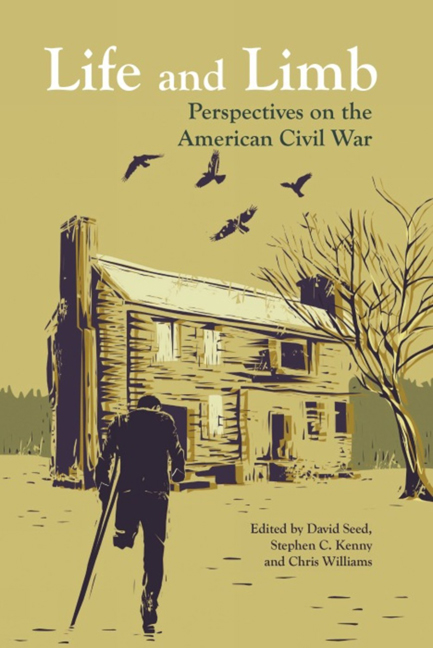Book contents
- Frontmatter
- Contents
- List of Illustrations
- Acknowledgements
- Introduction: Civil War Voices and Views
- MEDICAL AND SURGICAL MEMOIRS
- ACCOUNTS OF NURSING
- With the US Sanitary Commission: On the Hospital Boat Wilson Small: The Other Side of War
- Evacuation from Virginia, 1862: Hospital Transports
- Hospital Routine
- A Death in the Ward: Hospital Sketches
- Nurse and Spy: Nurse and Spy in the Union Army
- Front-line Nursing: Reminiscences of My Life in Camp
- ‘The Mute Look that Rolls and Moves’: Walt Whitman's Civil War
- Specimen Days & Collect
- MEDICAL FACILITIES AND PATHOLOGY
- PHOTOGRAPHY
- AMPUTATIONS AND PROSTHETIC LIMBS
- IN THE FIELD OF BATTLE
- POST-WAR NARRATIVES
- Contributors
- Select Bibliography
- Index
- Plates
Front-line Nursing: Reminiscences of My Life in Camp
from ACCOUNTS OF NURSING
- Frontmatter
- Contents
- List of Illustrations
- Acknowledgements
- Introduction: Civil War Voices and Views
- MEDICAL AND SURGICAL MEMOIRS
- ACCOUNTS OF NURSING
- With the US Sanitary Commission: On the Hospital Boat Wilson Small: The Other Side of War
- Evacuation from Virginia, 1862: Hospital Transports
- Hospital Routine
- A Death in the Ward: Hospital Sketches
- Nurse and Spy: Nurse and Spy in the Union Army
- Front-line Nursing: Reminiscences of My Life in Camp
- ‘The Mute Look that Rolls and Moves’: Walt Whitman's Civil War
- Specimen Days & Collect
- MEDICAL FACILITIES AND PATHOLOGY
- PHOTOGRAPHY
- AMPUTATIONS AND PROSTHETIC LIMBS
- IN THE FIELD OF BATTLE
- POST-WAR NARRATIVES
- Contributors
- Select Bibliography
- Index
- Plates
Summary
The daughter of Georgia slaves, Susie King Taylor (1848–1912) served as nurse and teacher in the Union army without pay. In 1862 she became the first African American teacher to freed slaves on St. Simon's Island, Georgia, and married an African American officer in the Union army, where she was the first black nurse to serve. Through her life she held a number of teaching posts.
The below excerpt is taken from Chapter 6 (‘On Morris and Other Islands’) of Taylor's Reminiscences of My Life in Camp with the 33d United States Coloured Troops, Late 1st S.C. Volunteers, written in the 1890s, published in 1902. Fort Wagner on Morris Island was a heavily fortified location for guarding Charleston Harbour.
Mary A. Gardner Holland, who saw nursing experience herself, produced a commemorative collection in Our Army Nurses. Interesting Sketches, Addresses and Photographs of nearly One Hundred of the Noble Women who Served in Hospitals and on Battlefields during Our Civil War (Boston: B. Williams, 1895). She made no bones about her patriotic purpose, declaring: ‘It seems to me that had I died battling for my country's honour, that my right hand would almost leap from its entombed dust to strike back the arm that would dare drag our flag from its high standard of glory’ (17).
For further information see Susan-Mary Grant, ‘To Bind Up the Nation's Wounds: Women and the American Civil War’, in Kleinberg, S.J., Boris, E., Ruiz, V.L., eds, The Practice of US Women's History: Narratives, Intersections, and Dialogues (New Brunswick, NJ: Rutgers University Press, 2007), pp. 106–25.
Fort Wagner being only a mile from our camp, I went there two or three times a week, and would go up on the ramparts to watch the gunners send their shells into Charleston (which they did every fifteen minutes), and had a full view of the city from that point. Outside of the fort were many skulls lying about; I have often moved them one side out of the path. The comrades and I would have quite a debate as to which side the men fought on. Some thought they were the skulls of our boys; others thought they were the enemy's; but as there was no definite way to know, it was never decided which could lay claim to them.
- Type
- Chapter
- Information
- Life and LimbPerspectives on the American Civil War, pp. 36 - 38Publisher: Liverpool University PressPrint publication year: 2015



